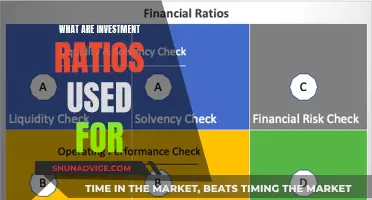
If you are a US citizen with investment income from sources outside the United States, you must report this income on your tax return unless it is exempt by US law. This is true whether you reside inside or outside the United States and whether or not you receive a Form 1099 from the foreign payer.
The IRS provides a range of forms and instructions for reporting investment income, including:
- Form 1040, U.S. Individual Income Tax Return
- Form 1040-SR, U.S. Income Tax Return for Seniors
- Form 1099, General Instructions for Certain Information Returns
- Form 1099-INT, Interest Income
- Form 1099-DIV, Dividends and Distributions
- Form 1099-OID, Original Issue Discount
- Form 8960, Net Investment Income Tax—Individuals, Estates, and Trusts
- Form 3468, Investment Credit
- Form 4952, Investment Interest Expense Deduction
| Characteristics | Values |
|---|---|
| IRS forms for investment profit | 1040, 1040-SR, 1099-INT, 1099-DIV, 1099-OID, 1099-PATR, 2439, 3115, 3468, 4952, 525, 537, 560, 571, 575, 590-A, 590-B, 6198, 6251, 721, 8582, 8615, 8814, 8815, 8818, 8824, 8949 |
| IRS form for net investment income tax | 8960 |
| IRS form for investment credit | 3468 |
What You'll Learn

Investment Income
When filing your taxes, you must report your total ordinary dividends on line 3b of Form 1040 or 1040-SR. Qualified dividends are reported separately on line 3a. If your ordinary dividends exceed $1,500, you must complete Schedule B (Form 1040), Part II, and attach it to your tax return.
It is important to note that not all distributions are treated as dividend income. Nondividend distributions, for instance, are a type of return on your investment and do not count as taxable income until your basis in the stock has been recovered. Liquidating distributions, which occur during the partial or complete liquidation of a corporation, are also treated differently. They are typically considered a return of capital and are only taxed as capital gains after your basis in the stock has been reduced to zero.
Additionally, certain types of investment income are exempt from taxation. For example, interest on tax-exempt state and local government bonds is generally not taxable. Similarly, interest on certain federally guaranteed state or local obligations issued after 1983 is also tax-exempt.
Furthermore, if you have investment expenses, such as interest paid to acquire investment property or expenses incurred to manage or collect income from investment property, these may be deductible. However, the rules outlined in Publication 550 do not apply to investments held in individual retirement arrangements (IRAs) or other qualified retirement plans.
Finally, it is worth mentioning that there are additional taxes and credits related to investment income. The Net Investment Income Tax (NIIT), for instance, is a 3.8% tax on net investment income for individuals with income above certain threshold amounts. On the other hand, you may be eligible for the Investment Credit, which includes credits for qualifying advanced coal projects, qualifying gasification projects, and qualifying advanced energy projects.
Using Revocable Trusts for Investing: A Guide
You may want to see also

Investment Interest Expenses
The IRS defines property held for investment as any property producing interest, dividends, annuities, royalties, and gain-generating property other than that used in a trade or business activity or passive activity.
The IRS Form 4952 is used to figure out the amount of investment interest expense one can deduct for the current year and the amount that can be carried forward to future years. The investment interest expense deduction is limited to one's net investment income.
Net investment income is defined as the excess of investment income over investment expenses. Investment income includes gross income from property held for investment, the excess of any net gain over any net capital gain resulting from the disposition of investment property, and qualified dividend income and net capital gain from the disposition of investment property.
Investment expenses are the deductions allowed (other than interest) that are directly related to the production of investment income.
Investing in Cash Balance Plans: Understanding Your Options
You may want to see also

Net Investment Income Tax
The Net Investment Income Tax (NIIT) is a 3.8% tax on the lesser of an individual's net investment income or the amount by which their modified adjusted gross income exceeds the statutory threshold amount based on their filing status. The NIIT was imposed by section 1411 of the Internal Revenue Code and came into effect on January 1, 2013.
Who owes the Net Investment Income Tax?
Individuals will owe the NIIT if they have net investment income and also have a modified adjusted gross income over the following thresholds:
- Married filing jointly
- Married filing separately
- Head of household (with qualifying person)
- Qualifying widow(er) with dependent child
In general, net investment income includes, but is not limited to:
- Interest
- Dividends
- Capital gains
- Rental and royalty income
- Non-qualified annuities
- Income from businesses involved in trading financial instruments or commodities
- Income from businesses that are passive activities to the taxpayer
The following are some examples of income that is not included in net investment income:
- Wages
- Unemployment compensation
- Social Security Benefits
- Alimony
- Self-employment income
- Alaska Permanent Fund Dividends
Individuals, estates, and trusts will use Form 8960 to compute their Net Investment Income Tax. For individuals, the tax will be reported on, and paid with, the Form 1040. For estates and trusts, the tax will be reported on, and paid with, the Form 1041.
Understanding Cash Investing Activities: A Beginner's Guide
You may want to see also

Investment Credit
- Qualifying advanced coal project
- Qualifying gasification project
- Qualifying advanced energy project
You can use Form 3468 to claim the investment credit. The investment credit is designed to encourage investment in qualifying advanced coal projects, qualifying gasification projects, and qualifying advanced energy projects. The amount of the investment credit that can be claimed depends on the specific type of investment and the year in which it was made.
If you have previously claimed the investment credit and your investment ceases to qualify for the credit, you may need to recapture (pay back) some or all of the credit that you claimed. You can use Form 4255 to figure out the amount of investment credit that needs to be recaptured.
Outside Investment: Blessing or Cash Flow Curse?
You may want to see also

Investment Interest Expense Deduction
Investment interest expense is interest paid or accrued on loans used to purchase or carry property held for investment. This does not include interest on loans for tax-exempt investments, such as municipal bonds, or qualified residence interest.
The amount of investment interest expense that can be deducted is limited to the individual's net investment income for the year. Net investment income is calculated as the excess of investment income over investment expenses. Investment income includes gross income from property held for investment, such as interest and dividends, as well as any net gain from the disposition of investment property. Investment expenses are the deductions allowed (other than interest) that are directly related to the production of investment income.
Any leftover investment interest expense that cannot be deducted in the current year can be carried forward to future years.
It is important to note that for tax years 2018 to 2025, "miscellaneous itemized deductions" have been eliminated. This includes deductions for expenses such as fees for investment advice, IRA custodial fees, and accounting costs necessary to produce or collect taxable income.
Fidelity Scanning for Value Investing: A Guide
You may want to see also
Frequently asked questions
You need to use Form 1040 or 1040-SR to report your investment income. You may also need to complete Schedule B (Form 1040) if your ordinary dividends are more than $1,500 or you received dividends as a nominee for someone else.
You need to use Form 4952 to figure out how much of your investment interest expense you can deduct for the current year and how much you can carry forward to future years.
You need to use Form 8960 to figure out how much you owe in net investment income tax.







